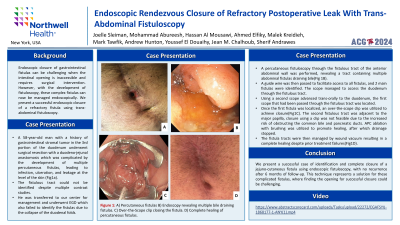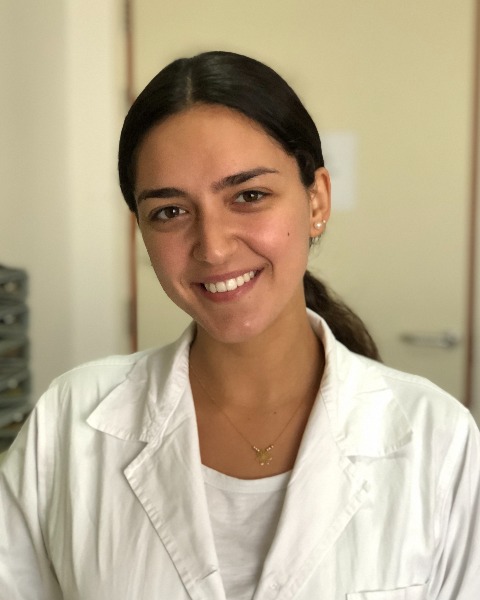Tuesday Poster Session
Category: Endoscopy Video Forum
P3882 - Endoscopic Rendezvous Closure of Refractory Postoperative Leak With Trans-Abdominal Fistuloscopy
Tuesday, October 29, 2024
10:30 AM - 4:00 PM ET
Location: Exhibit Hall E

Has Audio

Joelle Sleiman, MD
Staten Island University Hospital, Northwell Health
Staten Island, NY
Presenting Author(s)
Joelle Sleiman, MD, Mohammad Abureesh, MD, Hassan Al Moussawi, MD, Ahmed ` Elfiky, MD, Malek Kreidieh, MD, Mark Tawfik, DO, Andrew Hunton, PA, Youssef El Douaihy, MD, Jean M. Chalhoub, MD, Sherif Andrawes, MD
Staten Island University Hospital, Northwell Health, Staten Island, NY
Introduction: Endoscopic closure of gastrointestinal fistulas can be challenging when the intestinal opening is inaccessible and will need surgical intervention. However, with the development of fistuloscopy, these complex fistulas can now be managed endoscopically. We present a successful endoscopic closure of a refractory fistula using trans-abdominal fistuloscopy.
Case Description/Methods: A 58-year-old-man presented to the emergency room with epigastric abdominal pain. The patient underwent upper endoscopy revealing an ulcerated gastrointestinal stromal tumor in the 3rd portion of the duodenum. Subsequently, the patient underwent surgical resection in an outside hospital with a duodeno-jejunal anastomosis. However, it was complicated by the development of multiple percutaneous fistulas, leading to infection, ulceration, and leakage at the level of the skin. The fistulous tract could not be identified despite multiple contrast studies. He was transferred to our center for management and underwent an upper endoscopy, which also failed to identify the fistulas due to the collapse of the duodenal folds. A percutaneous fistuloscopy through the fistulous tract of the anterior abdominal wall was performed, revealing a tract containing multiple abdominal fistulas draining bile. A guide wire was then passed to facilitate access of all fistulas, and 2 main fistulas were identified. The scope managed to access the duodenum through the fistulous tract. Using a second scope advanced trans-orally to the duodenum, the first scope that had been passed through the fistulous tract was located. Once the first fistula was localized, an over the scope clip was utilized to achieve closure. The second fistulous tract was adjacent to the major papilla, closure using a clip was not feasible due to increased risk of obstructing of the common bile and pancreatic ducts. APC ablation with brushing was utilized to promote healing, after which drainage stopped. The fistula tracts were then managed by wound vacuum resulting in a complete healing despite prior treatment failures.
Discussion: We present a successful case of identification and complete closure of a jejuno-cutaneous fistula using endoscopic fistuloscopy, with no recurrence after 6 months of follow up. This technique represents a solution for these complicated fistulas, where finding the opening for successful closure could be challenging.
Disclosures:
Joelle Sleiman, MD, Mohammad Abureesh, MD, Hassan Al Moussawi, MD, Ahmed ` Elfiky, MD, Malek Kreidieh, MD, Mark Tawfik, DO, Andrew Hunton, PA, Youssef El Douaihy, MD, Jean M. Chalhoub, MD, Sherif Andrawes, MD. P3882 - Endoscopic Rendezvous Closure of Refractory Postoperative Leak With Trans-Abdominal Fistuloscopy, ACG 2024 Annual Scientific Meeting Abstracts. Philadelphia, PA: American College of Gastroenterology.
Staten Island University Hospital, Northwell Health, Staten Island, NY
Introduction: Endoscopic closure of gastrointestinal fistulas can be challenging when the intestinal opening is inaccessible and will need surgical intervention. However, with the development of fistuloscopy, these complex fistulas can now be managed endoscopically. We present a successful endoscopic closure of a refractory fistula using trans-abdominal fistuloscopy.
Case Description/Methods: A 58-year-old-man presented to the emergency room with epigastric abdominal pain. The patient underwent upper endoscopy revealing an ulcerated gastrointestinal stromal tumor in the 3rd portion of the duodenum. Subsequently, the patient underwent surgical resection in an outside hospital with a duodeno-jejunal anastomosis. However, it was complicated by the development of multiple percutaneous fistulas, leading to infection, ulceration, and leakage at the level of the skin. The fistulous tract could not be identified despite multiple contrast studies. He was transferred to our center for management and underwent an upper endoscopy, which also failed to identify the fistulas due to the collapse of the duodenal folds. A percutaneous fistuloscopy through the fistulous tract of the anterior abdominal wall was performed, revealing a tract containing multiple abdominal fistulas draining bile. A guide wire was then passed to facilitate access of all fistulas, and 2 main fistulas were identified. The scope managed to access the duodenum through the fistulous tract. Using a second scope advanced trans-orally to the duodenum, the first scope that had been passed through the fistulous tract was located. Once the first fistula was localized, an over the scope clip was utilized to achieve closure. The second fistulous tract was adjacent to the major papilla, closure using a clip was not feasible due to increased risk of obstructing of the common bile and pancreatic ducts. APC ablation with brushing was utilized to promote healing, after which drainage stopped. The fistula tracts were then managed by wound vacuum resulting in a complete healing despite prior treatment failures.
Discussion: We present a successful case of identification and complete closure of a jejuno-cutaneous fistula using endoscopic fistuloscopy, with no recurrence after 6 months of follow up. This technique represents a solution for these complicated fistulas, where finding the opening for successful closure could be challenging.
Disclosures:
Joelle Sleiman indicated no relevant financial relationships.
Mohammad Abureesh indicated no relevant financial relationships.
Hassan Al Moussawi indicated no relevant financial relationships.
Ahmed ` Elfiky indicated no relevant financial relationships.
Malek Kreidieh indicated no relevant financial relationships.
Mark Tawfik indicated no relevant financial relationships.
Andrew Hunton indicated no relevant financial relationships.
Youssef El Douaihy indicated no relevant financial relationships.
Jean Chalhoub indicated no relevant financial relationships.
Sherif Andrawes indicated no relevant financial relationships.
Joelle Sleiman, MD, Mohammad Abureesh, MD, Hassan Al Moussawi, MD, Ahmed ` Elfiky, MD, Malek Kreidieh, MD, Mark Tawfik, DO, Andrew Hunton, PA, Youssef El Douaihy, MD, Jean M. Chalhoub, MD, Sherif Andrawes, MD. P3882 - Endoscopic Rendezvous Closure of Refractory Postoperative Leak With Trans-Abdominal Fistuloscopy, ACG 2024 Annual Scientific Meeting Abstracts. Philadelphia, PA: American College of Gastroenterology.
